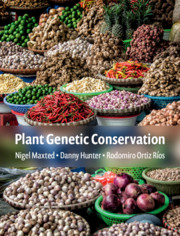Book contents
- Frontmatter
- Frontispiece
- Contents
- Foreword
- Preface
- Acknowledgements
- Part I Introduction
- Part II Scientific Background
- Part III Conservation Practice
- 6 Planning Plant Conservation
- 7 Conservation Strategies and Techniques
- 8 In Situ Conservation
- 9 On-Farm Conservation
- 10 Community-Based Conservation
- 11 Germplasm Collecting
- 12 Seed Gene Bank Conservation
- 13 Whole Plant, Plantlet and DNA Conservation
- Part IV Plant Exploitation
- Acronyms and Abbreviations
- Glossary
- References
- Index
- Plate section
13 - Whole Plant, Plantlet and DNA Conservation
from Part III - Conservation Practice
Published online by Cambridge University Press: 05 September 2020
- Frontmatter
- Frontispiece
- Contents
- Foreword
- Preface
- Acknowledgements
- Part I Introduction
- Part II Scientific Background
- Part III Conservation Practice
- 6 Planning Plant Conservation
- 7 Conservation Strategies and Techniques
- 8 In Situ Conservation
- 9 On-Farm Conservation
- 10 Community-Based Conservation
- 11 Germplasm Collecting
- 12 Seed Gene Bank Conservation
- 13 Whole Plant, Plantlet and DNA Conservation
- Part IV Plant Exploitation
- Acronyms and Abbreviations
- Glossary
- References
- Index
- Plate section
Summary
This chapter will look at the role of both field gene banks and living collections in botanical gardens and arboreta in ex situ conservation of plant diversity. In vitro conservation techniques are increasingly used for the conservation of vegetatively propagated species (e.g. potato, cassava, yam, taro, sweet potato, etc.) and species with recalcitrant seeds (e.g. apples, coconut, cocoa, coffee, oil palm, etc.), or even species that rarely produce seed (e.g. garlic, banana). The methodology takes explants (small pieces) from the whole plant, most appropriately the plant’s meristems, and places them in sterile culture, pathogen-free environment, for storage and subsequent use. In recent years there have been various refinements of the basic techniques to enhance storage, such as storage at ultra-low temperatures (cryopreservation) or the storage of samples of DNA and pollen. However, there are limitations to these techniques, such as genetic instability of plant material stored in tissue culture or the difficulty of regenerating whole plants from stored DNA and pollen.
Keywords
- Type
- Chapter
- Information
- Plant Genetic Conservation , pp. 368 - 390Publisher: Cambridge University PressPrint publication year: 2020
- 1
- Cited by



